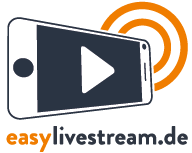The easylivestream basic package includes three static cameras, the direction of your livestream, a streaming destination or “playout channel” (Youtube, Twitter, etc.) and an internet connection via LTE. However, this package includes other services that happen more in the background. These include preparation and customer consulting, as well as corporate costs such as rent, marketing and software.
If you have chosen the basic package, you can decide for yourself whether you want to use the three static cameras or only need two or one for your production. We often receive requests from our customers to replace these cameras with a mobile option. However, one of the three static cameras cannot be replaced by a mobile DSLR camera. However, it can be booked in addition.
The advantage of the DSLR camera is that it allows close-ups. This makes it easier to capture emotions or detail shots and gives you the option to pan the camera if necessary. However, you can’t track an object permanently or leave the room, for example, because this DSLR camera is built on a tripod and thus has its limitations.
Here, the mobile 1-camera live stream can be the right solution. We don’t use a big DSLR camera, but simply an iPhone on a gimbal. The gimbal is used to provide the viewer with a steady image despite constant movement. This allows you to track a subject as well as change the shooting location at will during a live stream.
However, the mobile 1-camera live stream also has its drawbacks. Graphics such as name insertions or test boards and multimedia integrations such as presentations are not possible. The iPhone only allows close-ups by changing the distance and generally the live stream is limited to about two hours by the battery life.
Both the DSLR camera and the mobile 1-camera live stream have their advantages and disadvantages. If you are unsure which solution suits your event or you have a general question about either option, please feel free to contact us.

